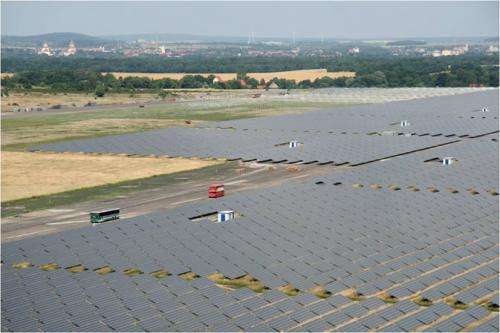October 27, 2015 report
Study suggests a ten-fold efficiency increase possible when converting carbon dioxide to fuel using solar energy

A trio of researchers with Lawrence Berkeley National Laboratory working at the Joint Center for Artificial Photosynthesis has found that it should be possible to achieve an approximate ten-fold increase in efficiency over natural photosynthesis, when converting carbon dioxide to fuel using solar energy. In their paper published in Proceedings of the National Academy of Sciences, Meenesh Singh, Ezra Clark and Alexis Bell describe the various scenarios they tested and why they believe it should be possible to achieve such boosts in efficiency.
Converting carbon dioxide to carbon monoxide and a blend of hydrogen, or better yet, to a mix of hydrogen and methane would offer the twin benefits of providing a cleaner fuel and removing carbon dioxide from the atmosphere. Such techniques mimic natural photosynthesis, but take the idea farther—plants range in efficiency from 0.5 to 2 percent—current technology bumps that up to approximately seven percent, but the researchers at Lawrence Berkeley believe it can be pushed much higher. They have been working under a program funded by the U.S. Department of Energy and hope to have a prototype within five years. In this latest work the team looked at four different types of artificial photosynthesis techniques, three of which rely on photoelectric cells (with different numbers of p-n junctions) the other involves a photovoltaic electrolyzer, which is a system where the photovoltaic component lies outside of the reaction chamber. As part of the study, they also looked at using copper or silver cathodes in the reactions.
The team has found that thus far, two configurations appear to be ideal—one should be able to produce a synthetic gas at 18.3 percent efficiency, while the other should be able to produce hythane at approximately 20.3 percent efficiency. Hythane, they note, produces far less emissions when burned, than either natural gas or diesel.
The team believes that any devices that emerge from their research would likely be used as part of a large solar complex, offering a way to "store" excess energy in a way that does not involve batteries, which the team believes are not sufficient to meet the needs of the future. They are not sure whether such devices would actually be able to pull the carbon dioxide directly from the surrounding air, however, noting that it might be a better idea to use a current source, such as gas generated from a natural gas well.
More information: Meenesh R. Singh et al. Thermodynamic and achievable efficiencies for solar-driven electrochemical reduction of carbon dioxide to transportation fuels, Proceedings of the National Academy of Sciences (2015). DOI: 10.1073/pnas.1519212112
Abstract
Thermodynamic, achievable, and realistic efficiency limits of solar-driven electrochemical conversion of water and carbon dioxide to fuels are investigated as functions of light-absorber composition and configuration, and catalyst composition. The maximum thermodynamic efficiency at 1-sun illumination for adiabatic electrochemical synthesis of various solar fuels is in the range of 32–42%. Single-, double-, and triple-junction light absorbers are found to be optimal for electrochemical load ranges of 0–0.9 V, 0.9–1.95 V, and 1.95–3.5 V, respectively. Achievable solar-to-fuel (STF) efficiencies are determined using ideal double- and triple-junction light absorbers and the electrochemical load curves for CO2 reduction on silver and copper cathodes, and water oxidation kinetics over iridium oxide. The maximum achievable STF efficiencies for synthesis gas (H2 and CO) and Hythane (H2 and CH4) are 18.4% and 20.3%, respectively. Whereas the realistic STF efficiency of photoelectrochemical cells (PECs) can be as low as 0.8%, tandem PECs and photovoltaic (PV)-electrolyzers can operate at 7.2% under identical operating conditions. We show that the composition and energy content of solar fuels can also be adjusted by tuning the band-gaps of triple-junction light absorbers and/or the ratio of catalyst-to-PV area, and that the synthesis of liquid products and C2H4 have high profitability indices.
© 2015 Tech Xplore
















